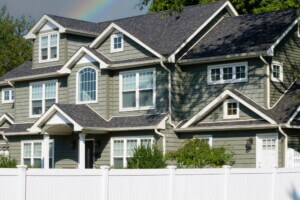Urban cores have become such a small portion of the built environment that they no longer embody the problems of mainstream urbanism. Today, 70 percent of American cities are suburban by area. Unlike the continuous blocks and streets that make up the arrangements of traditional urban cores, the cul-de-sac suburbs lack a public dimension. There are no mixed-use streets, few representational monuments, and no viable political arenas save privately owned commercial or administrative venues. In the suburban world, quotidian life has been entirely privatized.
As the overall expanse of the private, suburban world has steadily grown, the public urban core has been left to the yin and yang of blight and gentrification. And while reinvigorating urban cores is an important job for the architect, it distracts from another job that is of far greater urgency. Designers should no longer be satisfied with renovating the premodern cores of our existing cities. Instead, they should work to produce an alternative to the suburban world that we have built over the past seven decades.
Architects and urban designers have a responsibility to acknowledge that the traditional 30 percent of the built environment is gentrifying at an extremely rapid pace. Consequently, we are running out of historical urban infrastructure of continuous blocks and streets that support not only the spaces of public inclusion but the construction of a coherent city. We no longer construct traditional urbanism, where the whole is greater than the sum of its parts, and have not done so for the past 70 years. Over these years, the lack of urban construction has accelerated gentrification because the traditional infrastructure that remains is a limited commodity subject to price escalations common in any finite market.
When we understand that the extent of traditional urbanism is limited, we also understand that the principal role of the architect within the historical city is to serve as an agent of gentrification. But those pursuing gentrification do not need our attention— the displaced subjects of gentrification do.
Over countless cycles of urbanization, we have come to accept gentrification as an ageless and never-ending cycle of decline and renewal. Since it is always with us, we assume there is nothing to be done about it, at least not as far as design is concerned. From this perspective, there is no such thing as what comes “after” gentrification because gentrification is a process that seemingly never ends.
But when the urban frontier collapses—when we run out of the infrastructure that allows for an urban world to exist—then the process we have historically known as gentrification ends and another process begins. This process is much more politically charged, as it is characterized by a unique form of disenfranchisement.
After gentrification, those who are pushed out of older, traditional neighborhoods cannot afford to move to other urban areas. Instead, they seek affordability beyond the urban frontier in suburban zones. Gentrification is not pushing displaced individuals out into older, dilapidated urban areas where they can reclaim their public status as a coherent constituency. They are instead being pushed out into suburban oblivion. In the suburbs today, there is no public world for those disenfranchised by gentrification to reinhabit, notwithstanding the advent of virtual spaces. While those who enjoy the fruits of gentrification thrive, those who find themselves on the wrong side of the massive neoliberal income gap are pushed out into an isolated environment for which the brutal anonymity of the online world is no match.
Urban alternatives existed for previous generations, but that is no longer the case today. There are no urban alternatives. There are only the suburbs, whose deficiencies go far beyond a lack of a public existence. Today’s victims of gentrification are pushed into a totally privatized world defined by cultural, political, and economic exclusion. They occupy neighborhoods in which the closest thing to urbanism is a rundown strip center or a franchised service road off an interurban freeway. They enter the disempowering isolation of a privatized world. In the absence of mixed-use pedestrian streets or any other shared terrain, what remains of shared public spaces amounts to little more than unkempt parks, half-used parking lots, or empty athletic stadiums. In coming decades, as the proportion of suburban development reaches 80 and 90 percent in many metropolitan regions, it is the suburb, not the traditional city, that will most desperately require urban reform.
Across the globe, the gentrification of prewar building stock proceeds at different rates. European capitals are more advanced; their ossification has been triggered largely by tight preservation laws and the extraordinary growth of mass tourism. (It might come as a surprise to many Americans that more than 80 percent of Parisians live outside the historical arrondissements bound by the urban périphérique.) Gentrification in London and Madrid pushes inhabitants into even greater isolation as, each day, their cores come to resemble the hollowed-out stage set that is Venice. Two of New York’s five boroughs are thoroughly gentrified, as are urban areas of San Francisco and Boston. Others, like Austin or San Diego, are rapidly catching up. While percentages of suburban development vary, there is no question as to where the process leads in each of these cities. Once the current cycle of gentrification is complete and the historical building stock is turned over to the tourists and to the one percent, only the suburbs remain.
Today, the job of the architect is not the gentrification of traditional real estate but designing substitutes for the suburbs’ disempowering alienation. Architects are tasked with producing an alternative to the privatized suburban world into which the disenfranchised will otherwise disappear. Along with such a call to action, it should be made clear that there are few villains in this situation. We are all complicit in the privatization of the city, and we are all implicated in pursuing self-interest at the expense of the public world. All of us have indulged in some portion of the past seven decades of postwar consumerism, and we are now suffering its consequences, even those who have been able to remain within urban areas. As the historical city shrinks in relation to the expanse of the all-consuming built environment, it becomes sclerotic, as do the public values it once represented. After gentrification, there is one appropriate response: to elevate the status of the suburban through the creation of a public realm within our private worlds. Perhaps only when the historic cores of our cities are fully gentrified will we realize that we have all become suburban.
Albert Pope is the Gus Sessions Wortham Professor of Architecture at Rice Architecture. He teaches in the school’s undergraduate and graduate programs and directs its Present/Future program.











